The 12 Best Education Articles From November: Texas Looks to Take Control of Houston Schools, Segregated Pre-K Classrooms, a New Approach in Teaching Slavery & More
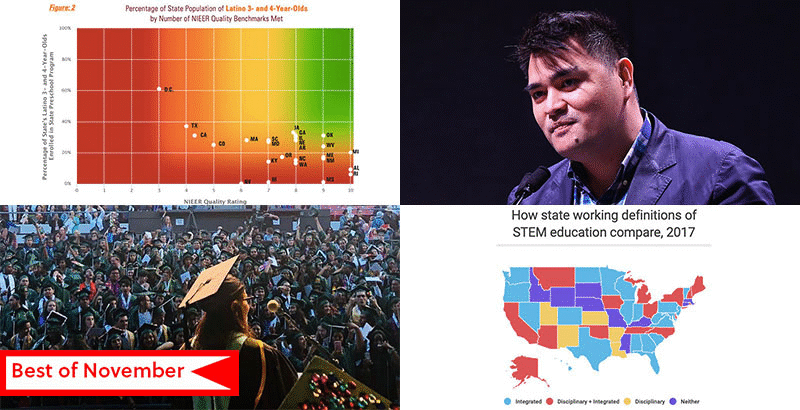
Every month, we round up our most popular and buzzed-about articles from the past four weeks. (Go deeper: See our top highlights from October, September and beyond right here)
It was a month of scoops and surprises here at The 74, from our reporting on schools in Los Angeles and New York City to our summaries of surprising developments involving the state takeover of schools in Houston, the astonishing racial divide that’s emerging in pre-K programs coast to coast, and the alarming indicators of just how much Texas’s refusal to provide special education services to students has derailed academic careers.
More details on the month’s most buzzed-about stories below. (You can always get our top news and analysis delivered straight to your inbox by signing up for The 74 Newsletter)
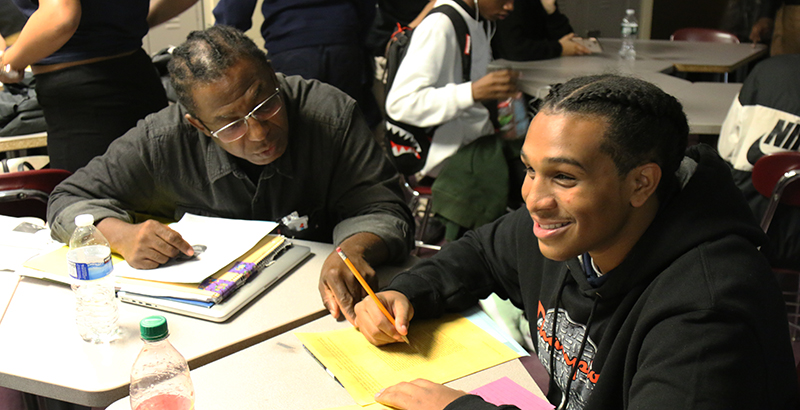
A Manhattan High School Reframes How Slavery Is Taught Using The New York Times’s 1619 Project
Curriculum: Over years of classes, 11th-grader Jeremias Mata had viewed slavery with a certain simplicity and hopelessness — that many black people had once been slaves and that was that. This year, learning about slavery has been different for students at Manhattan’s Facing History School, partly because teachers are incorporating The New York Times’s 1619 Project — a compilation of essays and poetry that re-examines slavery’s legacy in the U.S. 400 years after the first enslaved people arrived here from West Africa. The project is helping schools nationwide reframe how slavery is taught in a way that captures its brutality, complexity and influence in shaping America, while also affirming the experience as integral to black Americans’ identity and their contributions to the country. This reframing is “extremely important, especially with the student body that we teach here,” says history teacher Eric Albino. New York City is a predominantly black and Hispanic district that struggles with inequity and segregation.
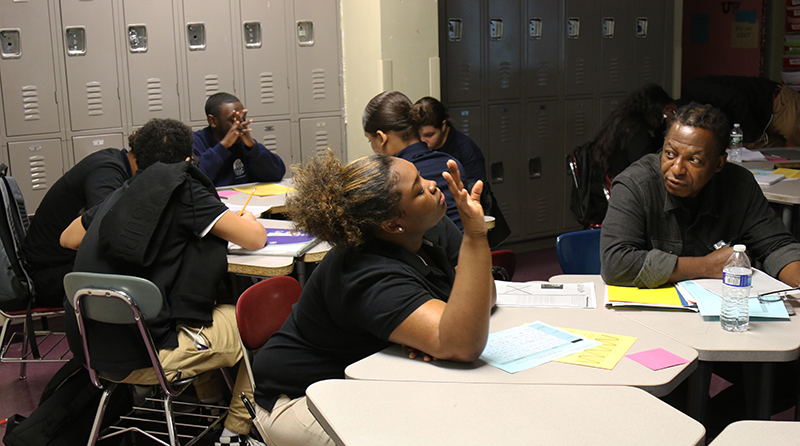
Teaching curriculum that is relevant to the experiences and perspectives of students of color has been a major — if not universally embraced — policy push of New York City Schools Chancellor Richard Carranza, though the practice isn’t mandated across the country’s largest school system. The 74’s Taylor Swaak visited the Facing History School to see the 1619 Project in action. (Read more about the new curriculum)
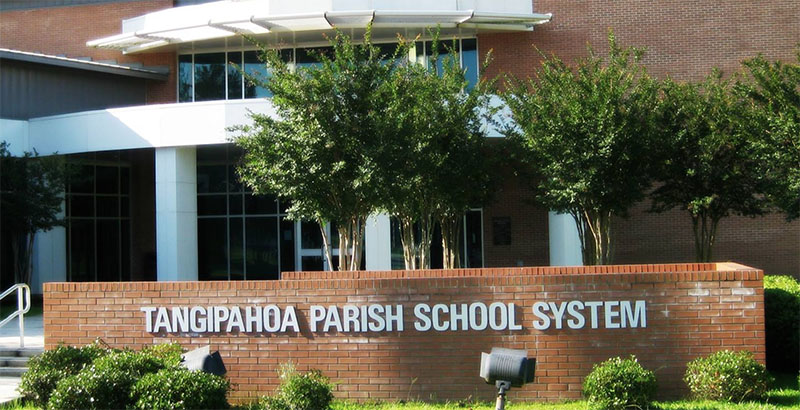
Integration: In the years after Brown v. Board of Education, the United States entered a contract with its black citizens: Their children would no longer be consigned to separate, inferior schools, and if districts attempted to keep them out, they would have their day in court. Hundreds of cases were filed, petitioning judges to break down barriers between black and white students in school assignments, facilities, learning materials and budgets. One was triggered in 1965 in southeastern Louisiana’s little-known Tangipahoa Parish, where a local truck driver and father of 15 sued the local school board for providing black students with a substandard education. The children of Tangipahoa not only got their day in court — since the day the case was filed, they’ve received the equivalent of 19,925 days. That may soon be changing, though, as both sides in Moore v. Tangipahoa Parish School Board have asked a federal judge to approve an extensive settlement in one of the longest-running desegregation cases in the country. Kevin Mahnken reports on the history of the case, and what awaits. (Read the full profile)
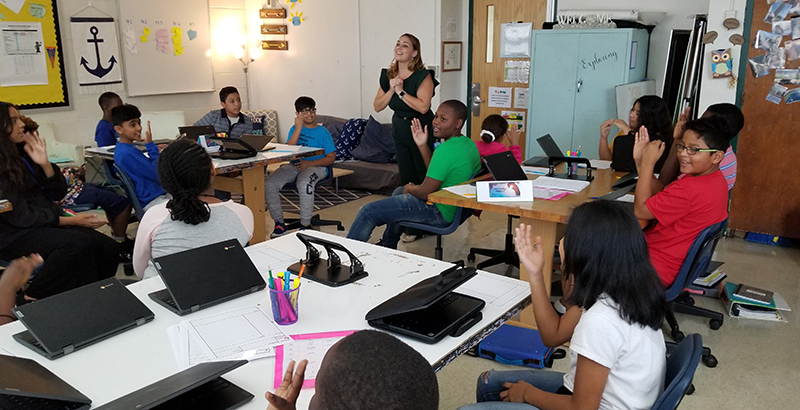
College Success: The nonprofit college-readiness program AVID serves some 2 million students in 7,000 mostly high-poverty schools. AVID, which stands for Advancement Via Individual Determination, seemed effective, 74 contributor Richard Whitmire notes, but until enough of its students were six years out of high school, it was too soon to tell. No longer. AVID now has 82,807 alumni who’ve reached that mark, and among those, 42 percent who are either low-income or first-generation college-goers earned bachelor’s degrees within six years of leaving high school. That’s compared to 11 percent for students of similar backgrounds nationwide. Whitmire, author of The B.A. Breakthrough: How Ending Diploma Disparities Can Change the Face of America, goes into schools in Alexandria, Virginia, and Riverside, California, to profile how AVID fosters college potential in students, many of them English learners who would be the first in their families to go. One aspect of AVID that stands out is that its staff begins working to build that mindset and prepare students long before they reach high school. (Read the full article)
● The B.A. Breakthrough: Read more from Richard Whitmire’s new book on the push to guide more low-income students to — and through — college at The74Million.org/Breakthrough
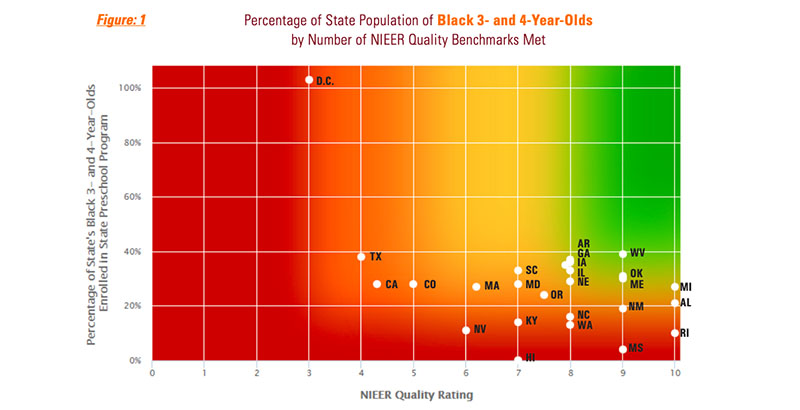
Report: Few Black and Latino Children Are Served by High-Quality State Preschool Programs
Early Education: Just 1 percent of Latino children and 4 percent of black children are enrolled in high-quality state preschool programs, according to a new report by The Education Trust. Across 25 states and Washington, D.C., no state-funded preschool programs provided black and Latino children with sufficient access to high-quality programs, the think tank found. In fact, researchers discovered a sort of seesaw pattern: As access for black and Latino children improved, quality diminished. But as program quality improved, fewer black and Latino children were represented. (Read more about the data)
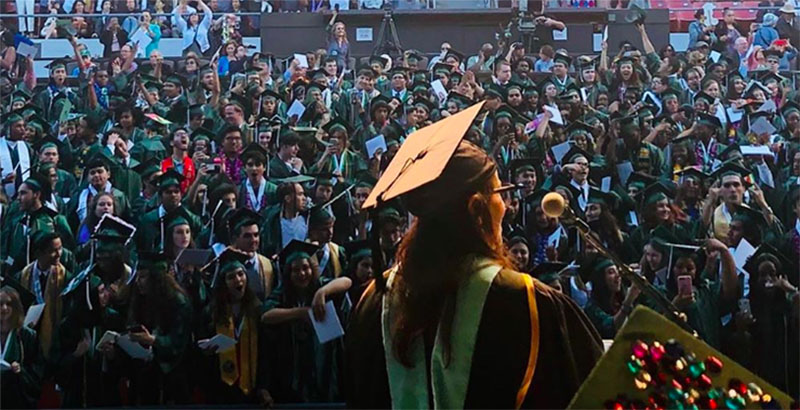
Graduation Requirements: The California State University system will continue discussions on whether to add a fourth year of math/quantitative reasoning (think statistics, or personal finance) to its admission requirements starting in 2027. New data obtained by The 74, however, reveal that fewer than a quarter of high school seniors in L.A. Unified School District — California’s largest — took such a course in 2018-19. And when they did, it was solely math, according to the district’s Office of General Counsel. For advocates, the latest data validate fears that the proposed change could bar more minority and low-income students from enrolling in the nation’s largest four-year public university system. This should be “raising alarm bells for everyone,” said Elisha Smith Arrillaga, executive director of Education Trust-West. There appears to be disagreement between advocates and the university, though, on whom the proposal ultimately affects and what data matter as the system moves forward. The admissions change is not concerned with systemic college-readiness challenges statewide and in districts like L.A., a university official said, but with “CSU-bound students” and whether it’s “reasonable to ask them to take one additional course to strengthen their preparation for college success.” (Read more about the numbers)

As Texas Moves to Replace Houston’s School Board, Here Are 7 Things to Know About the Takeover
Takeover: When it first looked as if the Texas Education Agency would take over the Houston Independent School District Board of Education, talk centered on the district’s failure to increase academic performance in a group of impoverished schools that had failed to meet state standards for years. But as board members fought about how to address the issues and whether to ignore or take advantage of a law that provided a path to forestalling state intervention, more problems surfaced.
Now, with evidence of secret board meetings and trustees attempting to steer contracts and meddle in everyday district business, state officials say board members should have focused some of the energy they brought to their battles on supporting long-neglected schools. As state Education Commissioner Mike Morath moves forward with a takeover unprecedented in Texas history, Beth Hawkins offers seven observations. (Read the full breakdown)
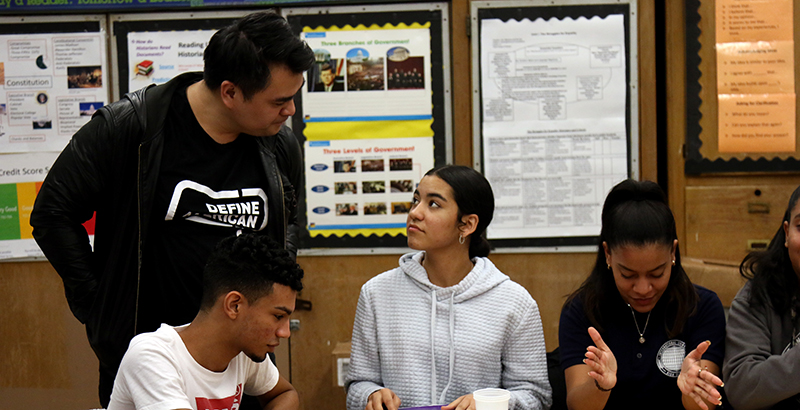
SCOTUS: Journalist and immigration activist Jose Antonio Vargas had been in the New York City classroom for only a few minutes when a student dropped a pointed question: “What finally led you to come out as an undocumented immigrant?” During a recent visit to International Community High School in the South Bronx, Vargas shared with immigrant students why he made the risky decision to disclose his immigration status. But as the Supreme Court prepared to hear a case that could decide the fate of the Deferred Action for Childhood Arrivals program, Vargas highlighted to the teens in the classroom the importance of resilience. Don’t let fear prevent you from being successful, he said. “I have to live my life knowing that I’m free, that I don’t need papers to be free,” he said. “I don’t need this government, or any government, to give me value.” (Read more by The 74’s Mark Keierleber)
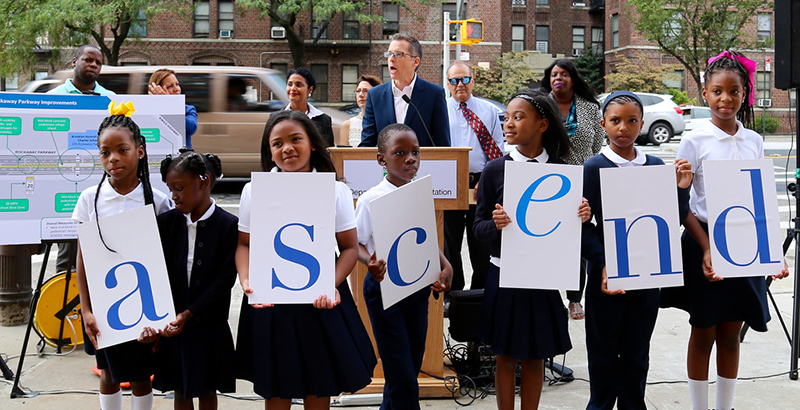
Commentary: When contributor Robin Lake began examining unequal opportunity and outcomes in public education 25 years ago, she was compelled in part by working in tandem — if not always in agreement — with people who believed that public education was failing too many students. Education reformers from the left and right came together around one idea: There are systemic reasons for unequal opportunity. Overcoming those systemic barriers required people who didn’t agree about many other things to work together. But now, she writes, much to the delight of powerful special interests that want to protect the status quo in K-12 education, this united reform front is weakening. Amid new suspicions, assumptions and accusations, the question “Are you an ally?” is being asked in schools and organizations across the country today — and the competing answers are threatening to tear apart the increasingly fragile political coalitions working to improve our nation’s schools. “Deep reflection (and meaningful action) on the role of race, equity and power is essential work for every person and organization working in education and in America,” she says. “But this work will amount to nothing if it is not also grounded in a harsh realism about what it will take to win in the most important fight there is: the fight for young people and their futures … if we continue to focus only on adult divisions, kids will lose.” (Read the full essay)
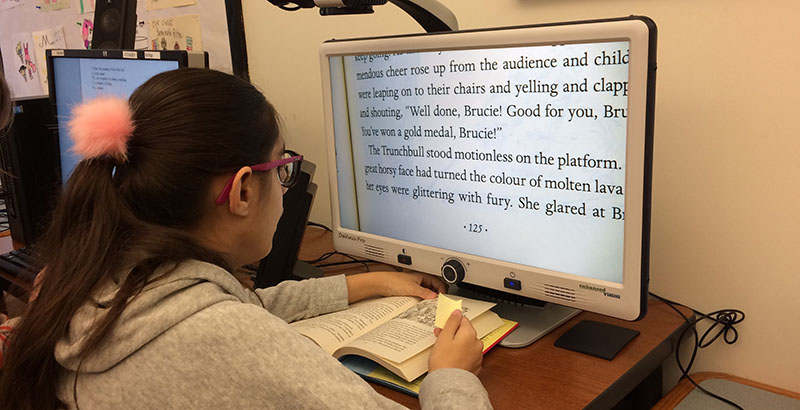
Texas: The mass denials of special education supports to Texas students that quietly began in 2004 sparked a scandal and a federal investigation when the illegal cap was revealed in 2016. But they also presented a unique opportunity for two researchers interested in the effects of special ed on academic outcomes for children with disabilities. Because Texas forced students off schools’ special ed rolls to cut costs, the researchers were able to compare children who got services with their classmates who didn’t. The results were far more dramatic than they imagined: Students with mild to moderate disabilities who lost services were 52 percent less likely to graduate from high school and 38 percent less likely to enroll in college than if they had been allowed to continue in special ed. Low-income children of color and students in impoverished districts bore the brunt of the failure. One conclusion: The impact of special education on this population is as valuable as high-quality early childhood education. (Read more about the details from Beth Hawkins)

Discipline: A recent report finds high suspension rates for Native American students in California schools. It calculates that California’s 30,000 Native American students are expelled at higher rates than any other student group in the state. Mikhail Zinshteyn speaks to the authors about the findings, how they tie into the country’s long history of abuse of Native American populations and why the report argues that the districts with small enrollments and high disciplinary rates shouldn’t dismiss the data as rounding errors. “There’s always this piece of trying to remove Native people again and again from the data,” said one of the authors. (Read the full article)
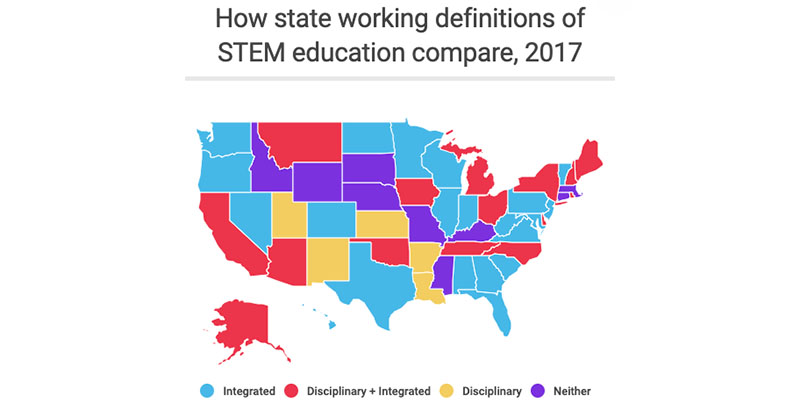
The Great STEM Debate: States Can’t Agree on What Those Four Letters Mean, and That’s a Problem
Standards: STEM is one of the best-known acronyms in education, but it might also be among the most disagreed-upon. National and state-level agencies define STEM in a host of different ways, and there’s no guarantee that even within a state, various frameworks for STEM education align. STEM was originally thought up as a way to help students prepare for lucrative careers in science and technology, and part of the confusion might come from the tricky process of translating adult jobs to kids in classrooms. But the fogginess around just what STEM means has big consequences for career readiness in the U.S., researchers say — especially as other countries zoom ahead in these fields to meet economic demand. In advance of National STEM/STEAM Day, Noble Ingram explores the big disagreement around four (or five) little letters. (Read the full report)

Coloring Outside the Lines: Good Special Education Isn’t a Place; It’s a Mindset
Special Education: For most of the 1 in 5 U.S. students who receive disability services in school, special education is a place to be sent to. General education teachers, research shows, feel poorly equipped to meet their needs and are often unsure whether inclusion — the mainstreaming of children with disabilities — will work. A new report by the Center on Reinventing Public Education and the National Center for Special Education in Charter Schools found that public charter schools that do well with students with disabilities are set up, physically and philosophically, in a way that requires special ed and general ed teachers to assume collective responsibility for student success. Beth Hawkins reaches back to her autistic daughter’s last year in a traditional middle school for a practical example of what this means and why it’s a game-changer. (Read the full commentary)
Go Deeper: Get the day’s top news and analysis delivered straight to your inbox by signing up for The 74 Newsletter
Help fund stories like this. Donate now!

;)